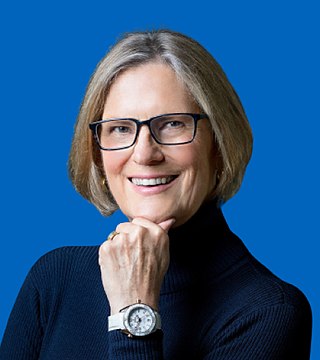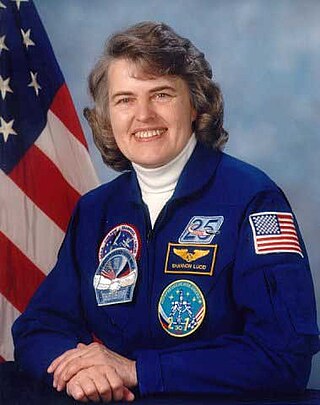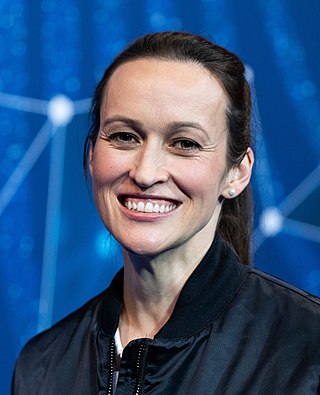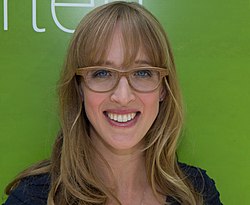
Sally Kristen Ride was an American astronaut and physicist. Born in Los Angeles, she joined NASA in 1978, and in 1983 became the first American woman and the third woman to fly in space, after cosmonauts Valentina Tereshkova in 1963 and Svetlana Savitskaya in 1982. She was the youngest American astronaut to have flown in space, having done so at the age of 32.

Peggy Annette Whitson is an American biochemistry researcher, retired NASA astronaut, former NASA Chief Astronaut, and an active Axiom Space astronaut. Whitson has a total of 675 days in space, more than any other American or woman.

Kathryn Dwyer Sullivan is an American geologist, oceanographer, and former NASA astronaut and US Navy officer. She was a crew member on three Space Shuttle missions.

Shannon Matilda Wells Lucid is an American biochemist and retired NASA astronaut. She has flown in space five times, including a prolonged mission aboard the Russian space station Mir in 1996, and is the only American woman to have stayed on Mir. From 1996 to 2007, Lucid held the record for the longest duration spent in space by an American and by a woman. She was awarded the Congressional Space Medal of Honor in December 1996, making her the tenth person and the first woman to be accorded the honor.

Margaret Rhea Seddon is an American surgeon and retired NASA astronaut. After being selected as part of the first group of astronauts to include women in 1978, she flew on three Space Shuttle flights: as a mission specialist on STS-51-D and STS-40, and as a payload commander for STS-58, accumulating over 722 hours in space. On these flights, she built repair tools for a US Navy satellite and performed medical experiments.

Bonnie Jeanne Dunbar is an American engineer and retired NASA astronaut. She flew on five Space Shuttle missions between 1985 and 1998, including two dockings with the Mir space station.

Gerhard Paul Julius Thiele is a German physicist and a former ESA astronaut. He is the father of Die Astronautin candidate Insa Thiele-Eich.

Susan Kilrain is an American aerospace engineer, former United States Navy officer, and a former NASA astronaut. She is the youngest person to pilot a Space Shuttle. She has flown more than 3,000 hours and among her merits she was awarded with the Defense Superior Service Medal.

The Mercury 13 were thirteen American women who took part in a privately funded program run by William Randolph Lovelace II aiming to test and screen women for spaceflight. The participants—First Lady Astronaut Trainees as Jerrie Cobb called them—successfully underwent the same physiological screening tests as had the astronauts selected by NASA on April 9, 1959, for Project Mercury. While Lovelace called the project Woman in Space Program, the thirteen women became later known as the Mercury 13—a term coined in 1995 by Hollywood producer James Cross as a comparison to the Mercury Seven astronauts. The Mercury 13 women were not part of NASA's official astronaut program, never flew in space as part of a NASA mission, and never met as a whole group.

Patricia Consolatrix Hilliard Robertson was an American physician and a NASA astronaut. She died in a plane crash the year before she would have flown to the International Space Station.

Karen LuJean Nyberg is an American mechanical engineer and retired NASA astronaut. Nyberg became the 50th woman in space on her first mission in 2008. Nyberg holds a Ph.D in mechanical engineering. She started her space career in 1991 and spent a total of 180 days in space in 2008 and 2013 as a mission specialist on STS-124 and a flight engineer on Soyuz TMA-09M.

In 2011 NASA opened applications for Astronaut Group 21. The team was announced in June 2013 after a year and a half long search. With four men and four women, the class of 2013 had the highest percentage of female finalists. According to NASA astronaut Kathleen Rubins, "it's… a reflection of how many really talented women are in science and engineering these days." NASA received a total of over 6,300 applications, which made it the second highest number received at the time.

Women have flown and worked in outer space since almost the beginning of human spaceflight. A considerable number of women from a range of countries have worked in space, though overall women are still significantly less often chosen to go to space than men, and by June, 2020 constitute only 12% of all astronauts who have been to space. Yet, the proportion of women among space travelers is increasing substantially over time.

Nicola Winter is a German reserve astronaut and former fighter pilot. Winter became the second female fighter pilot in the history of the German Air Force in 2007 flying both Tornado and Eurofighter Typhoon in the German Air Force. In 2017, she was selected as an astronaut candidate for the private spaceflight organisation Die Astronautin, which aims to send the first German woman into space, but later withdrew from the programme. In 2022, she was named a reserve astronaut in the European Astronaut Corps.

Jessica Andrea Watkins is an American NASA astronaut, geologist, aquanaut and former international rugby player. Watkins was announced as the first Black woman who completed an International Space Station long-term mission in April 2022. On June 9, 2022, at 7:38 UTC, she became the African American woman with the most time in space, surpassing Stephanie Wilson's 42 day, 23 hour and 46 minute record.

Renate Luise Brümmer is a Swiss-born German meteorological scientist and former astronaut. Specialising in satellite meteorology, she was selected as an astronaut in 1987, retiring in 1993, having never been into space.
Johanna Maislinger is an Austrian aviator and engineer, currently employed by the German cargo carrier AeroLogic. Since 2010 she has flown Boeing 777-200F cargo jets, initially as a First Officer, as a Senior First Officer from 2011 and as a Captain since 2018. She achieved media prominence in 2018-2020 when she claimed to have secured financial and logistical backing to become a space tourist, on Soyuz MS-20, though she did not gain a seat on the mission. The Soyuz MS-20 mission launched 8 December 2021 without her on board.
Die Astronautin is a private German human spaceflight program with the goal of sending the first German woman into space by 2023 via a short-duration flight to the International Space Station. The program was launched by a German private initiative in March 2016, when it sent out a call for German women to apply for a mission to the ISS. The flight will be mainly funded by donors and voluntary financial aid and so far has not received any funding from the German government.

Suzanna Randall is a German astrophysicist working at the European Southern Observatory. In 2018, Randall was selected as an astronaut candidate by the private spaceflight organisation Die Astronautin, which aims to send the first German woman into space.

















